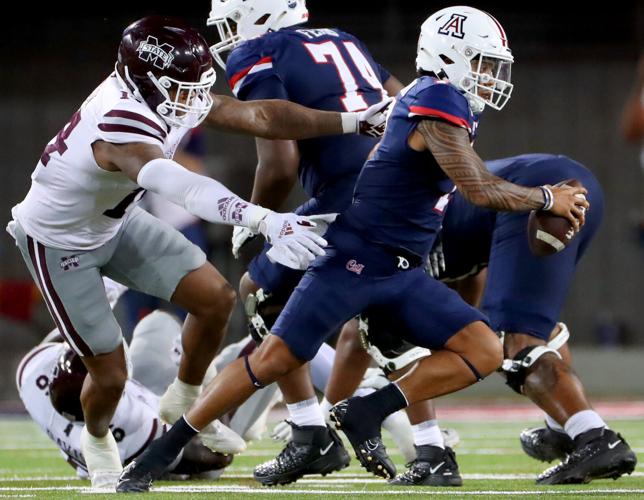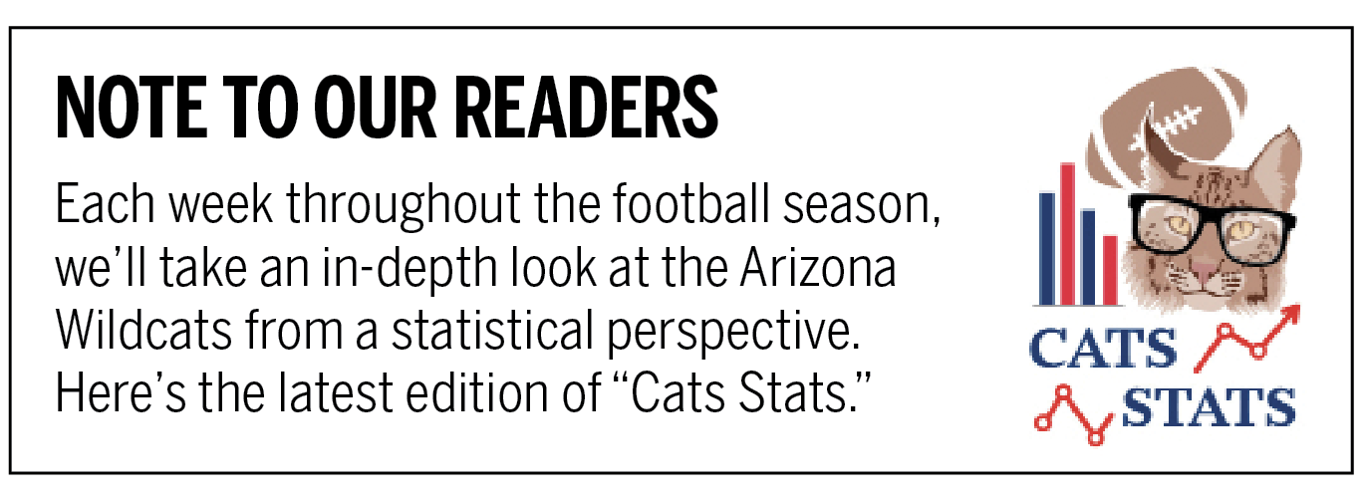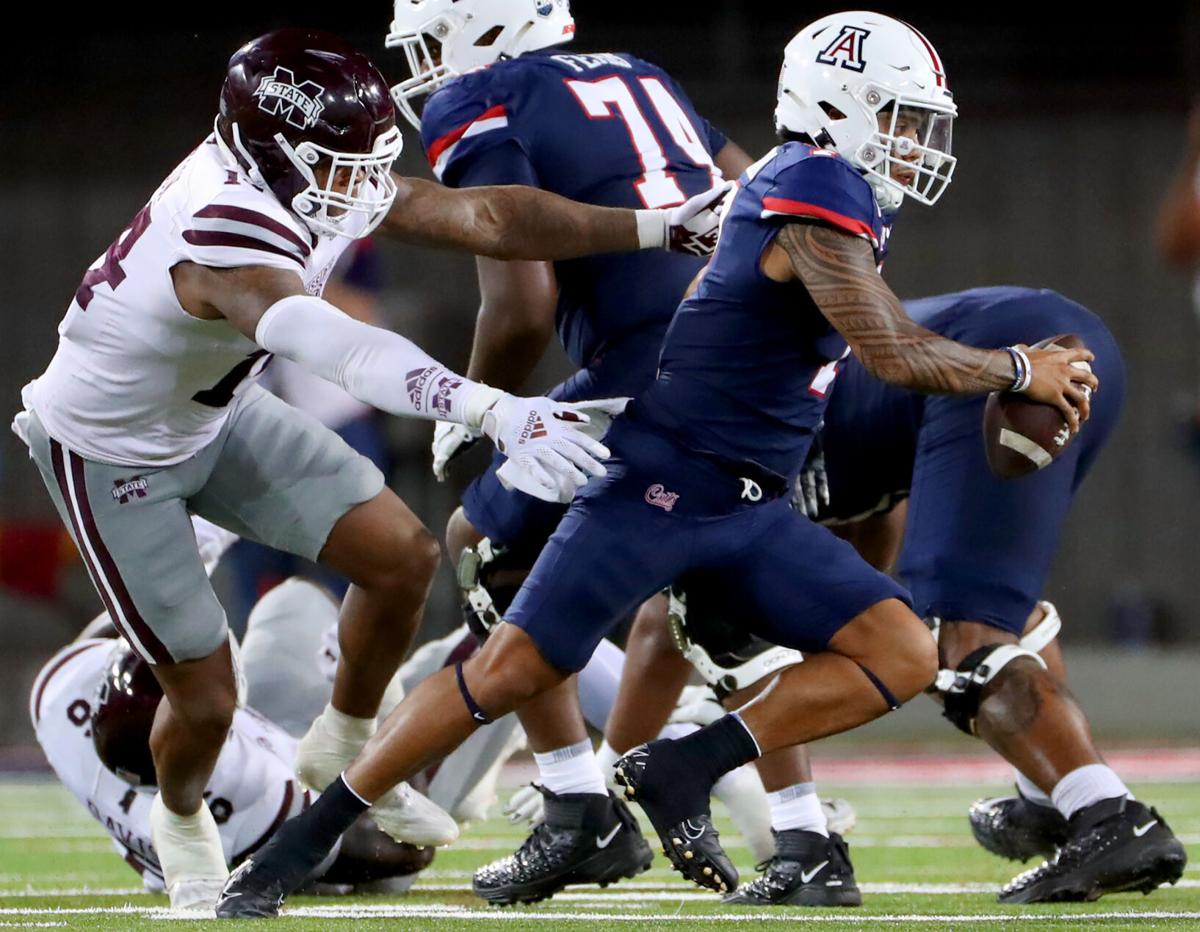In the aftermath of Arizona’s loss to Mississippi State, you’ve undoubtedly heard a couple of phrases used by Wildcats coaches and players.
1. "Behind the chains."
2. "Off schedule."
They basically mean the same thing — that the offense got into long-yardage situations that made it difficult to move the ball.
Ideally, you want to stay ahead of the chains and remain on schedule. When asked after the game why the offense seemed so out of sync, UA coach Jedd Fisch cited "down and distance."
"When we were ahead of the chains, we were OK," said Fisch, whose team hosts North Dakota State on Saturday. "We'd have a good drive, or a good four or five plays, and then we would get a negative or we would try to run the ball on second down and we’d lose a couple. We’d throw an incompletion on second-and-10, now it's third-and-10. We took sacks on two different drives. Those things can hurt you. We took a delay of game, which is very frustrating.
"We just probably didn’t stay ahead of the chains as much as we should."
Arizona didn’t run the ball very often or very effectively; the Wildcats’ 22 rushing attempts were their second fewest under Fisch, and their 40 net rushing yards were their lowest in his 14 games.
"It really felt like we got off schedule," offensive coordinator Brennan Carroll said of the run-game struggles.
He’s not wrong. But there’s another layer to this: Did being off schedule prevent Arizona from running the ball? Or did the Wildcats’ inability to run put them in those situations?
In this week’s "Cats Stats," we’ll explore what was behind Arizona so often being behind the chains. It starts with first down.

Arizona averaged 4.7 yards per play on first down. Mississippi State averaged 6.7 yards. The previous week, Arizona averaged 6.2 yards on first down. San Diego State averaged 3.6.
What changed for the UA offense on first down? The Wildcats couldn’t run the ball.
Against SDSU, Arizona gained 94 yards on 20 rushes (4.7 ypc) on first down. Against MSU, the Wildcats netted just 14 yards on nine rushes (1.6).
The latter is slightly misleading. In the first quarter, Arizona was charged with a "team rush" of minus-8 yards on the play where Jayden de Laura couldn’t handle Josh Baker’s high snap. So taking that out of the equation, the Wildcats had 22 yards on eight first-down carries. That’s an average of 2.8 yards per attempt — better, but still not good.
Arizona’s overall rushing output included that play and two sacks that accounted for 25 yards in losses. Excluding those plays, the Wildcats had 73 yards on 19 attempts — not great, but not terrible. However, when you take out Michael Wiley’s 34-yard touchdown run, you see the reality: 39 yards on 18 attempts.

Arizona running back Michael Wiley high-steps out of the hands of Mississippi State safety Jalen Green during last week's game. Wiley finished with a 34-yard touchdown run; take that away, and the UA gained just 39 yards on 18 attempts.
So was that it then? Was the UA’s inability to run the ball the reason it got behind the chains/off schedule?
Yes, but that tells only part of the story. On the Wildcats’ second possession, de Laura got sacked for a 10-yard loss on first-and-10. That was the play where a rusher was closing in on him, he flipped the ball to Wiley but subsequently was ruled down. The next play was an interception.
The high-snap rush for a loss also happened on first-and-10. Arizona ended up going three-and-out.
The Wildcats faced second-and-10 three times on their second full possession of the second quarter. All were the result of incomplete passes. The third instance became a second-and-15 because of a false start. Arizona ended up punting.
At the end of the half, a first-and-10 turned into a second-and-25 when de Laura went down instead of throwing the ball away. That took the Wildcats out of field-goal range and forced an unsuccessful, half-ending Hail Mary attempt.
(Odd note of the day: Arizona has been charged with three sacks this season. On none of those plays did de Laura actually get tackled by the opposing defense. In all three instances he hit the turf for one reason or another. If you include the high-snap play, it’d be four.)
In all, UA quarterbacks were 12 of 21 on first down — a completion rate of 57.1%. That’s about on par with the previous week’s rate of 58.3%. But Arizona had only five incomplete passes on first down vs. SDSU compared to nine vs. MSU. That’s nine situations where the Wildcats faced second-and-10. Meanwhile, Bulldogs quarterbacks were 20 of 23 on first down – setting them up for success.
Yardage gained on first down usually correlates to third-down conversion percentage. Arizona converted just 28.6% of its third downs in Week 2 compared to 46.1% in Week 1. Meanwhile, the Wildcats yielded a conversion rate of 41.7% in Week 2 after allowing just 18.2% in Week 1.
The "average to go" on third downs in the first two games also aligns with that premise. Arizona’s average distance needed on third downs swelled from 5.6 yards to 8.3. Its opponents’ average dropped from 6.3 yards to 5.5.
"Week 1, we were able to have positive plays on first and second down," Carroll said. "We got into a lot of third-and-long situations (against Mississippi State), which are never good. So that had something to do with our third-down percentage being lower than the first week. We want to, obviously, have successful first and second downs; that will help everything else out."
It’s to be determined whether the Wildcats can stay ahead of the chains against the Bison. NDSU has allowed only 2.7 yards per rush and 3.1 yards per play, but that was against Drake and North Carolina A&T. Arizona, even in its rebuilding state, represents a significant upgrade.
Still, the Wildcats can’t afford to be off schedule against anyone on their schedule. It simply isn’t a sustainable way to operate.







